Project Management Report: Project Management for Business
VerifiedAdded on 2020/01/07
|21
|5172
|392
Report
AI Summary
This report provides a comprehensive overview of project management principles and practices. It begins by defining projects and project management, discussing success metrics, and exploring the Dynamic System Development Method (DSDM), including its seven phases and nine principles. The report then analyzes different project management structures, outlining their strengths and weaknesses, and discusses the qualities of an effective project manager and how to build an efficient project team. Further, the report covers essential components of a project plan, the calculation of Budgeted Cost of Work Performed (BCWP), the attributes of an impartial project auditor, and the elements of a change control system. The conclusion summarizes the key findings and emphasizes the importance of effective project management for achieving business objectives. Finally, the report includes references to support the information presented.
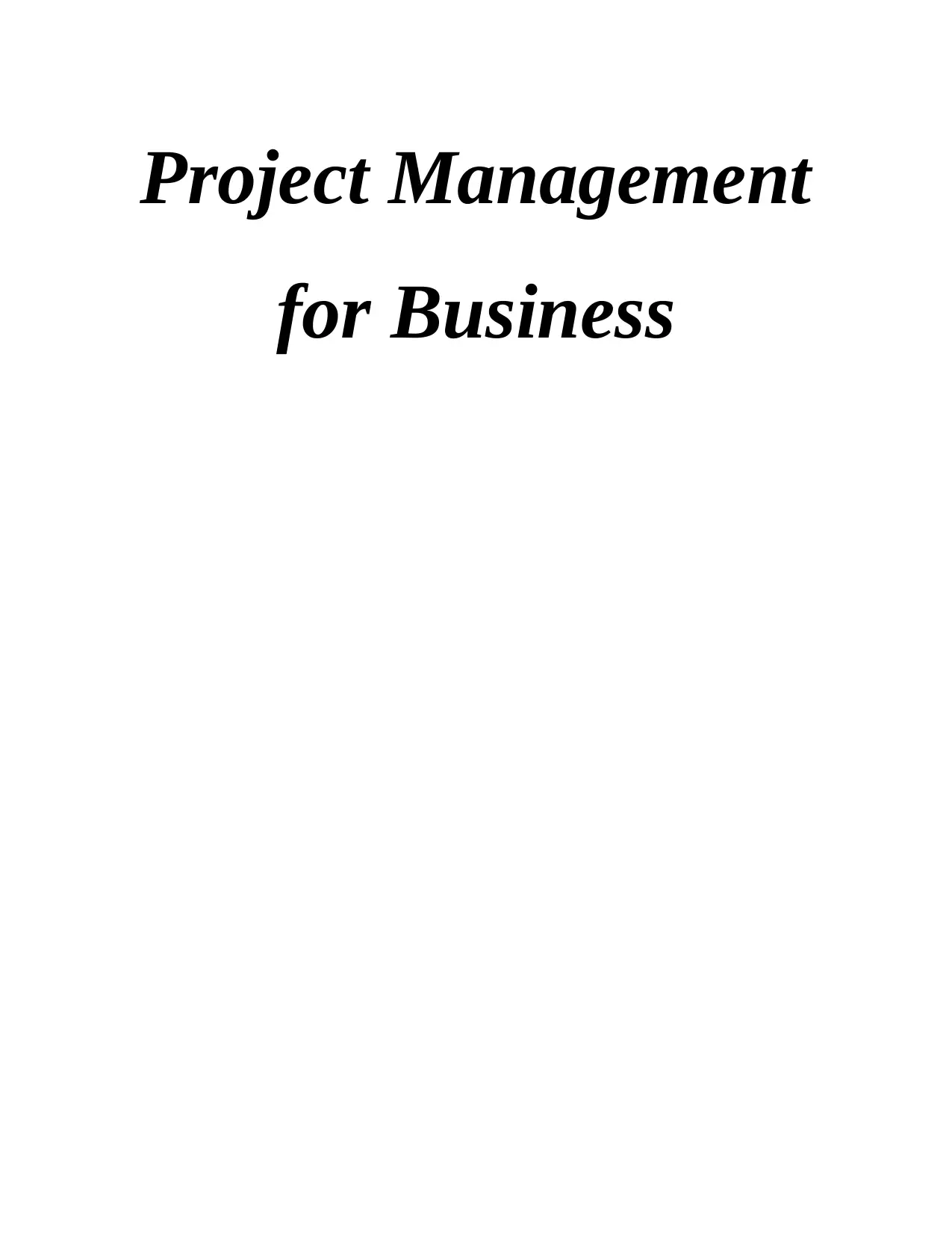
Project Management
for Business
for Business
Paraphrase This Document
Need a fresh take? Get an instant paraphrase of this document with our AI Paraphraser
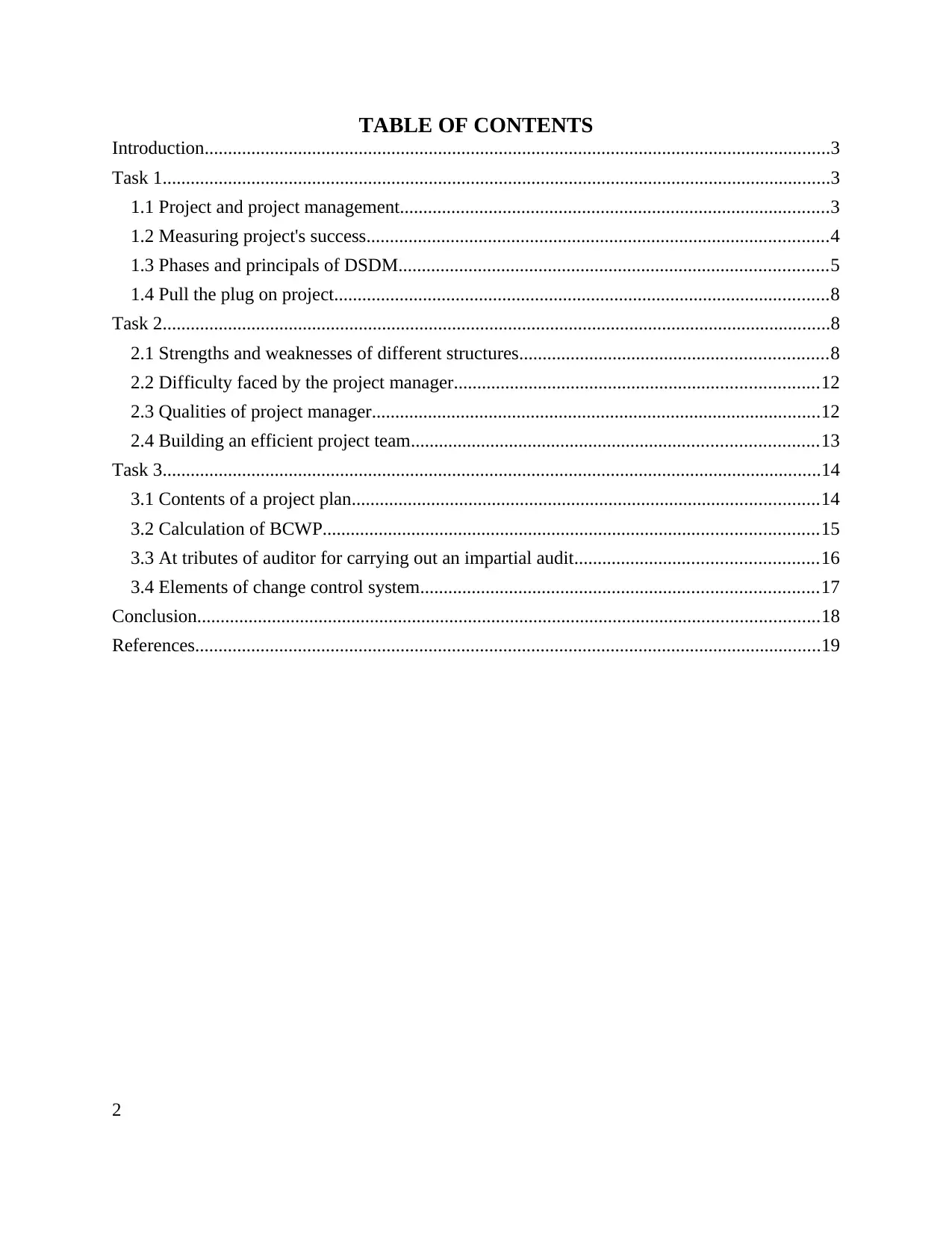
TABLE OF CONTENTS
Introduction......................................................................................................................................3
Task 1...............................................................................................................................................3
1.1 Project and project management............................................................................................3
1.2 Measuring project's success...................................................................................................4
1.3 Phases and principals of DSDM............................................................................................5
1.4 Pull the plug on project..........................................................................................................8
Task 2...............................................................................................................................................8
2.1 Strengths and weaknesses of different structures..................................................................8
2.2 Difficulty faced by the project manager..............................................................................12
2.3 Qualities of project manager................................................................................................12
2.4 Building an efficient project team.......................................................................................13
Task 3.............................................................................................................................................14
3.1 Contents of a project plan....................................................................................................14
3.2 Calculation of BCWP..........................................................................................................15
3.3 At tributes of auditor for carrying out an impartial audit....................................................16
3.4 Elements of change control system.....................................................................................17
Conclusion.....................................................................................................................................18
References......................................................................................................................................19
2
Introduction......................................................................................................................................3
Task 1...............................................................................................................................................3
1.1 Project and project management............................................................................................3
1.2 Measuring project's success...................................................................................................4
1.3 Phases and principals of DSDM............................................................................................5
1.4 Pull the plug on project..........................................................................................................8
Task 2...............................................................................................................................................8
2.1 Strengths and weaknesses of different structures..................................................................8
2.2 Difficulty faced by the project manager..............................................................................12
2.3 Qualities of project manager................................................................................................12
2.4 Building an efficient project team.......................................................................................13
Task 3.............................................................................................................................................14
3.1 Contents of a project plan....................................................................................................14
3.2 Calculation of BCWP..........................................................................................................15
3.3 At tributes of auditor for carrying out an impartial audit....................................................16
3.4 Elements of change control system.....................................................................................17
Conclusion.....................................................................................................................................18
References......................................................................................................................................19
2
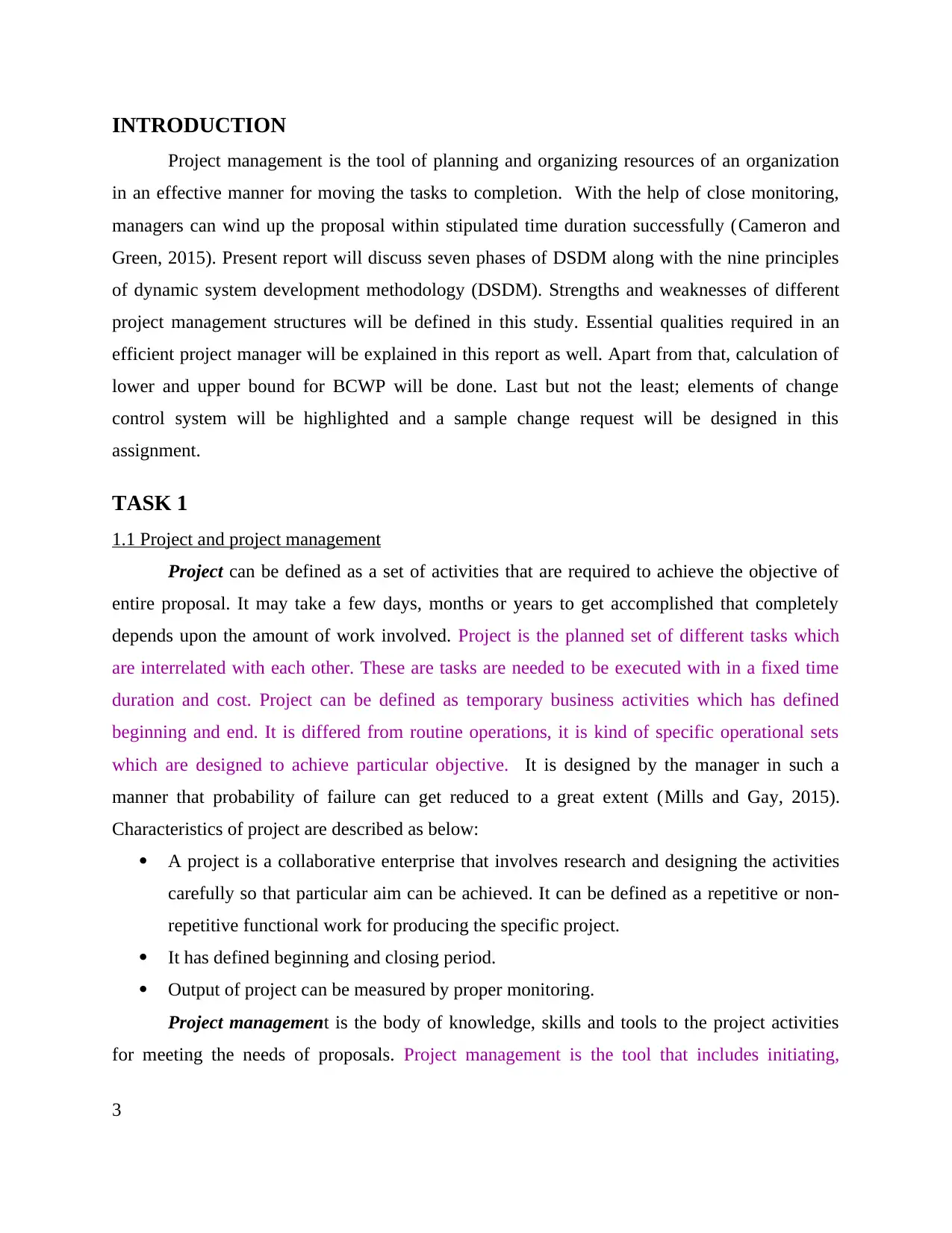
INTRODUCTION
Project management is the tool of planning and organizing resources of an organization
in an effective manner for moving the tasks to completion. With the help of close monitoring,
managers can wind up the proposal within stipulated time duration successfully (Cameron and
Green, 2015). Present report will discuss seven phases of DSDM along with the nine principles
of dynamic system development methodology (DSDM). Strengths and weaknesses of different
project management structures will be defined in this study. Essential qualities required in an
efficient project manager will be explained in this report as well. Apart from that, calculation of
lower and upper bound for BCWP will be done. Last but not the least; elements of change
control system will be highlighted and a sample change request will be designed in this
assignment.
TASK 1
1.1 Project and project management
Project can be defined as a set of activities that are required to achieve the objective of
entire proposal. It may take a few days, months or years to get accomplished that completely
depends upon the amount of work involved. Project is the planned set of different tasks which
are interrelated with each other. These are tasks are needed to be executed with in a fixed time
duration and cost. Project can be defined as temporary business activities which has defined
beginning and end. It is differed from routine operations, it is kind of specific operational sets
which are designed to achieve particular objective. It is designed by the manager in such a
manner that probability of failure can get reduced to a great extent (Mills and Gay, 2015).
Characteristics of project are described as below:
A project is a collaborative enterprise that involves research and designing the activities
carefully so that particular aim can be achieved. It can be defined as a repetitive or non-
repetitive functional work for producing the specific project.
It has defined beginning and closing period.
Output of project can be measured by proper monitoring.
Project management is the body of knowledge, skills and tools to the project activities
for meeting the needs of proposals. Project management is the tool that includes initiating,
3
Project management is the tool of planning and organizing resources of an organization
in an effective manner for moving the tasks to completion. With the help of close monitoring,
managers can wind up the proposal within stipulated time duration successfully (Cameron and
Green, 2015). Present report will discuss seven phases of DSDM along with the nine principles
of dynamic system development methodology (DSDM). Strengths and weaknesses of different
project management structures will be defined in this study. Essential qualities required in an
efficient project manager will be explained in this report as well. Apart from that, calculation of
lower and upper bound for BCWP will be done. Last but not the least; elements of change
control system will be highlighted and a sample change request will be designed in this
assignment.
TASK 1
1.1 Project and project management
Project can be defined as a set of activities that are required to achieve the objective of
entire proposal. It may take a few days, months or years to get accomplished that completely
depends upon the amount of work involved. Project is the planned set of different tasks which
are interrelated with each other. These are tasks are needed to be executed with in a fixed time
duration and cost. Project can be defined as temporary business activities which has defined
beginning and end. It is differed from routine operations, it is kind of specific operational sets
which are designed to achieve particular objective. It is designed by the manager in such a
manner that probability of failure can get reduced to a great extent (Mills and Gay, 2015).
Characteristics of project are described as below:
A project is a collaborative enterprise that involves research and designing the activities
carefully so that particular aim can be achieved. It can be defined as a repetitive or non-
repetitive functional work for producing the specific project.
It has defined beginning and closing period.
Output of project can be measured by proper monitoring.
Project management is the body of knowledge, skills and tools to the project activities
for meeting the needs of proposals. Project management is the tool that includes initiating,
3
⊘ This is a preview!⊘
Do you want full access?
Subscribe today to unlock all pages.

Trusted by 1+ million students worldwide
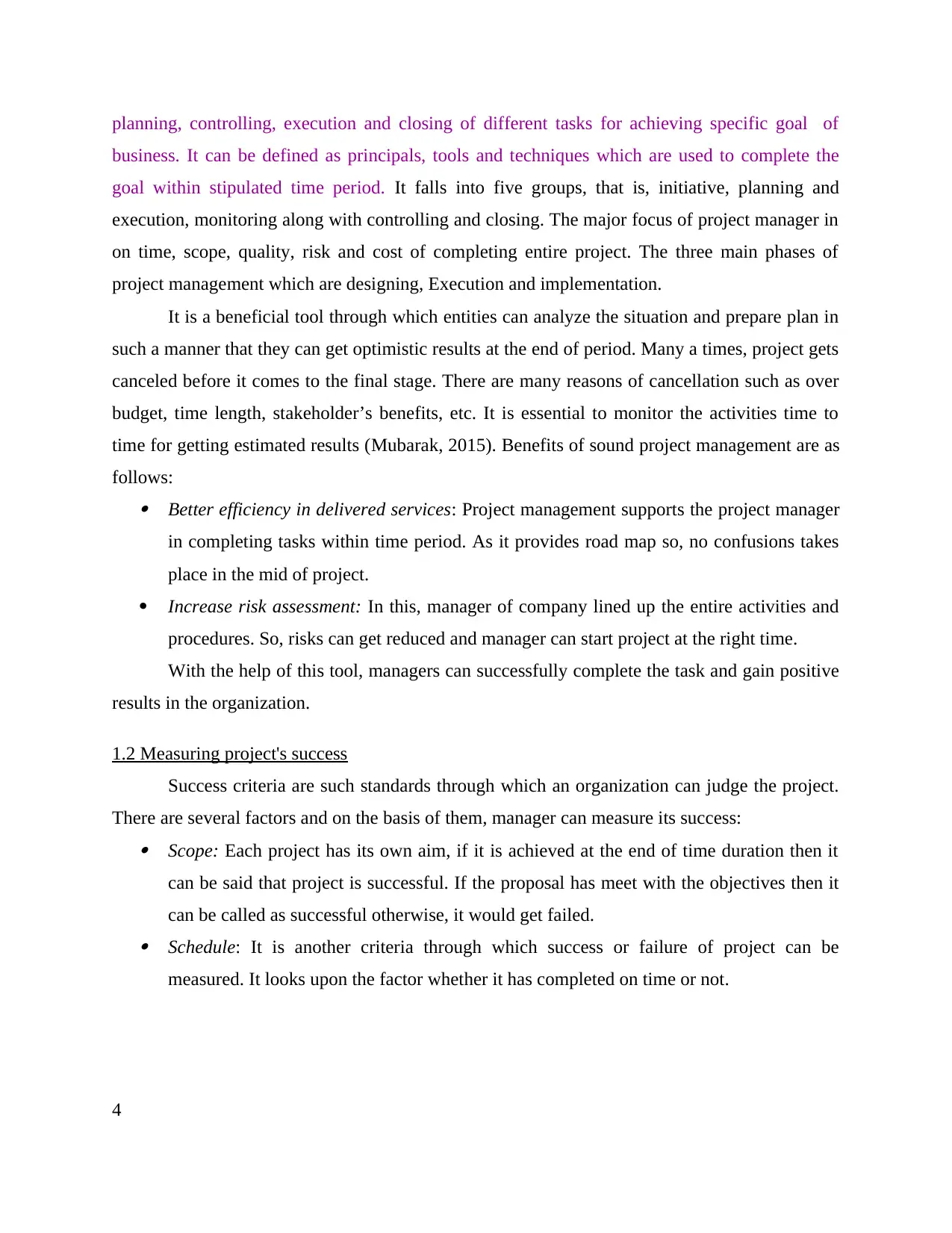
planning, controlling, execution and closing of different tasks for achieving specific goal of
business. It can be defined as principals, tools and techniques which are used to complete the
goal within stipulated time period. It falls into five groups, that is, initiative, planning and
execution, monitoring along with controlling and closing. The major focus of project manager in
on time, scope, quality, risk and cost of completing entire project. The three main phases of
project management which are designing, Execution and implementation.
It is a beneficial tool through which entities can analyze the situation and prepare plan in
such a manner that they can get optimistic results at the end of period. Many a times, project gets
canceled before it comes to the final stage. There are many reasons of cancellation such as over
budget, time length, stakeholder’s benefits, etc. It is essential to monitor the activities time to
time for getting estimated results (Mubarak, 2015). Benefits of sound project management are as
follows: Better efficiency in delivered services: Project management supports the project manager
in completing tasks within time period. As it provides road map so, no confusions takes
place in the mid of project.
Increase risk assessment: In this, manager of company lined up the entire activities and
procedures. So, risks can get reduced and manager can start project at the right time.
With the help of this tool, managers can successfully complete the task and gain positive
results in the organization.
1.2 Measuring project's success
Success criteria are such standards through which an organization can judge the project.
There are several factors and on the basis of them, manager can measure its success: Scope: Each project has its own aim, if it is achieved at the end of time duration then it
can be said that project is successful. If the proposal has meet with the objectives then it
can be called as successful otherwise, it would get failed. Schedule: It is another criteria through which success or failure of project can be
measured. It looks upon the factor whether it has completed on time or not.
4
business. It can be defined as principals, tools and techniques which are used to complete the
goal within stipulated time period. It falls into five groups, that is, initiative, planning and
execution, monitoring along with controlling and closing. The major focus of project manager in
on time, scope, quality, risk and cost of completing entire project. The three main phases of
project management which are designing, Execution and implementation.
It is a beneficial tool through which entities can analyze the situation and prepare plan in
such a manner that they can get optimistic results at the end of period. Many a times, project gets
canceled before it comes to the final stage. There are many reasons of cancellation such as over
budget, time length, stakeholder’s benefits, etc. It is essential to monitor the activities time to
time for getting estimated results (Mubarak, 2015). Benefits of sound project management are as
follows: Better efficiency in delivered services: Project management supports the project manager
in completing tasks within time period. As it provides road map so, no confusions takes
place in the mid of project.
Increase risk assessment: In this, manager of company lined up the entire activities and
procedures. So, risks can get reduced and manager can start project at the right time.
With the help of this tool, managers can successfully complete the task and gain positive
results in the organization.
1.2 Measuring project's success
Success criteria are such standards through which an organization can judge the project.
There are several factors and on the basis of them, manager can measure its success: Scope: Each project has its own aim, if it is achieved at the end of time duration then it
can be said that project is successful. If the proposal has meet with the objectives then it
can be called as successful otherwise, it would get failed. Schedule: It is another criteria through which success or failure of project can be
measured. It looks upon the factor whether it has completed on time or not.
4
Paraphrase This Document
Need a fresh take? Get an instant paraphrase of this document with our AI Paraphraser
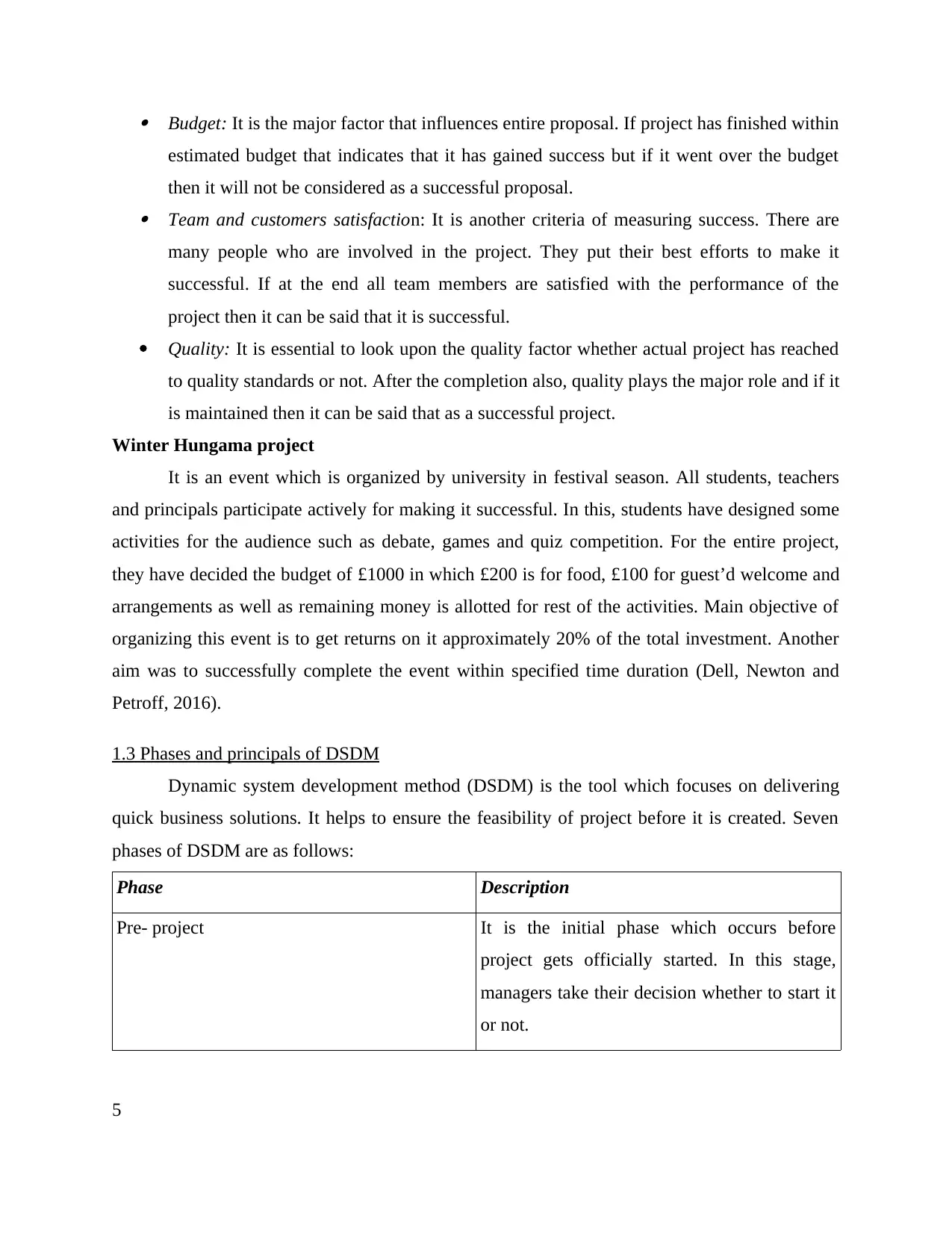
Budget: It is the major factor that influences entire proposal. If project has finished within
estimated budget that indicates that it has gained success but if it went over the budget
then it will not be considered as a successful proposal. Team and customers satisfaction: It is another criteria of measuring success. There are
many people who are involved in the project. They put their best efforts to make it
successful. If at the end all team members are satisfied with the performance of the
project then it can be said that it is successful.
Quality: It is essential to look upon the quality factor whether actual project has reached
to quality standards or not. After the completion also, quality plays the major role and if it
is maintained then it can be said that as a successful project.
Winter Hungama project
It is an event which is organized by university in festival season. All students, teachers
and principals participate actively for making it successful. In this, students have designed some
activities for the audience such as debate, games and quiz competition. For the entire project,
they have decided the budget of £1000 in which £200 is for food, £100 for guest’d welcome and
arrangements as well as remaining money is allotted for rest of the activities. Main objective of
organizing this event is to get returns on it approximately 20% of the total investment. Another
aim was to successfully complete the event within specified time duration (Dell, Newton and
Petroff, 2016).
1.3 Phases and principals of DSDM
Dynamic system development method (DSDM) is the tool which focuses on delivering
quick business solutions. It helps to ensure the feasibility of project before it is created. Seven
phases of DSDM are as follows:
Phase Description
Pre- project It is the initial phase which occurs before
project gets officially started. In this stage,
managers take their decision whether to start it
or not.
5
estimated budget that indicates that it has gained success but if it went over the budget
then it will not be considered as a successful proposal. Team and customers satisfaction: It is another criteria of measuring success. There are
many people who are involved in the project. They put their best efforts to make it
successful. If at the end all team members are satisfied with the performance of the
project then it can be said that it is successful.
Quality: It is essential to look upon the quality factor whether actual project has reached
to quality standards or not. After the completion also, quality plays the major role and if it
is maintained then it can be said that as a successful project.
Winter Hungama project
It is an event which is organized by university in festival season. All students, teachers
and principals participate actively for making it successful. In this, students have designed some
activities for the audience such as debate, games and quiz competition. For the entire project,
they have decided the budget of £1000 in which £200 is for food, £100 for guest’d welcome and
arrangements as well as remaining money is allotted for rest of the activities. Main objective of
organizing this event is to get returns on it approximately 20% of the total investment. Another
aim was to successfully complete the event within specified time duration (Dell, Newton and
Petroff, 2016).
1.3 Phases and principals of DSDM
Dynamic system development method (DSDM) is the tool which focuses on delivering
quick business solutions. It helps to ensure the feasibility of project before it is created. Seven
phases of DSDM are as follows:
Phase Description
Pre- project It is the initial phase which occurs before
project gets officially started. In this stage,
managers take their decision whether to start it
or not.
5
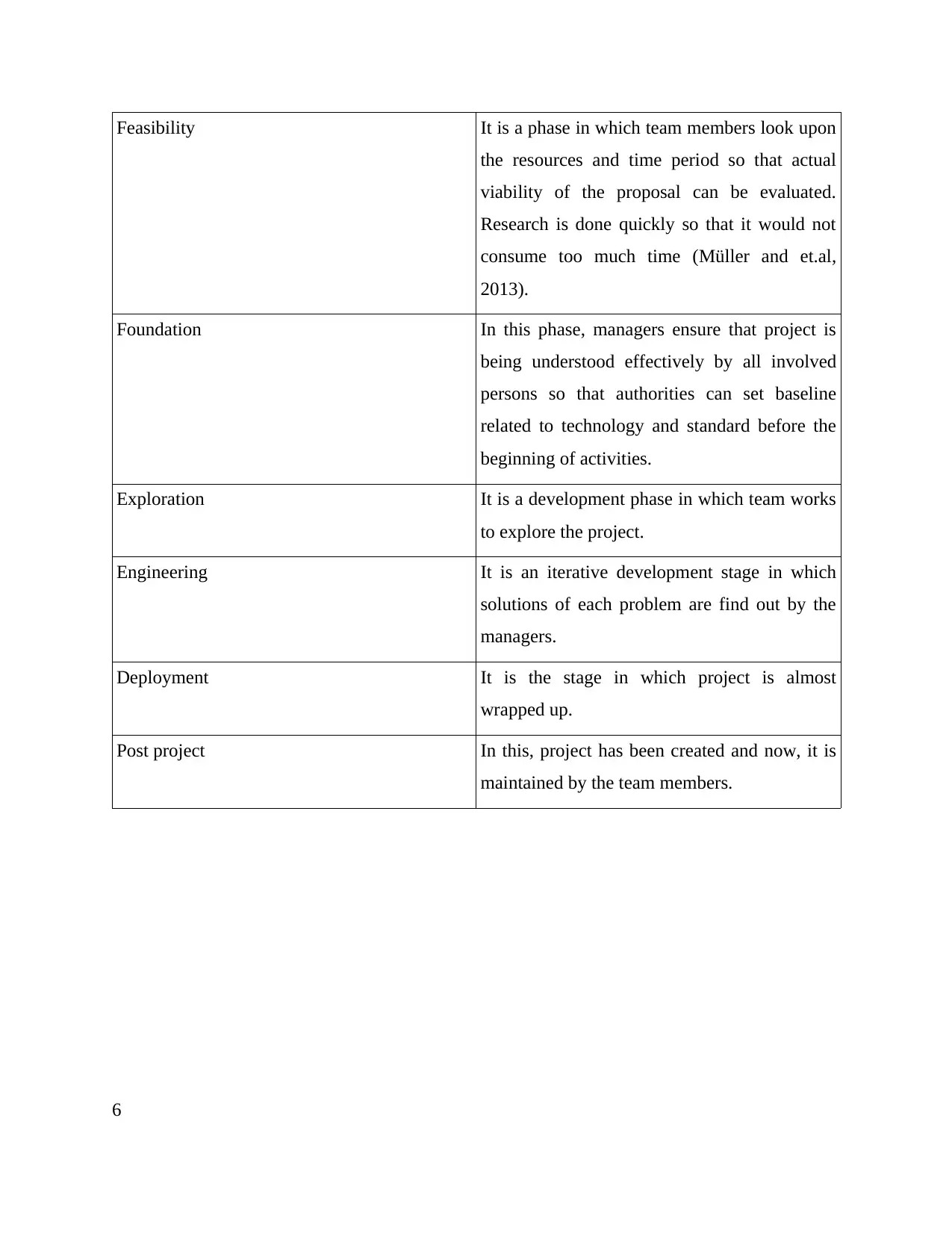
Feasibility It is a phase in which team members look upon
the resources and time period so that actual
viability of the proposal can be evaluated.
Research is done quickly so that it would not
consume too much time (Müller and et.al,
2013).
Foundation In this phase, managers ensure that project is
being understood effectively by all involved
persons so that authorities can set baseline
related to technology and standard before the
beginning of activities.
Exploration It is a development phase in which team works
to explore the project.
Engineering It is an iterative development stage in which
solutions of each problem are find out by the
managers.
Deployment It is the stage in which project is almost
wrapped up.
Post project In this, project has been created and now, it is
maintained by the team members.
6
the resources and time period so that actual
viability of the proposal can be evaluated.
Research is done quickly so that it would not
consume too much time (Müller and et.al,
2013).
Foundation In this phase, managers ensure that project is
being understood effectively by all involved
persons so that authorities can set baseline
related to technology and standard before the
beginning of activities.
Exploration It is a development phase in which team works
to explore the project.
Engineering It is an iterative development stage in which
solutions of each problem are find out by the
managers.
Deployment It is the stage in which project is almost
wrapped up.
Post project In this, project has been created and now, it is
maintained by the team members.
6
⊘ This is a preview!⊘
Do you want full access?
Subscribe today to unlock all pages.

Trusted by 1+ million students worldwide
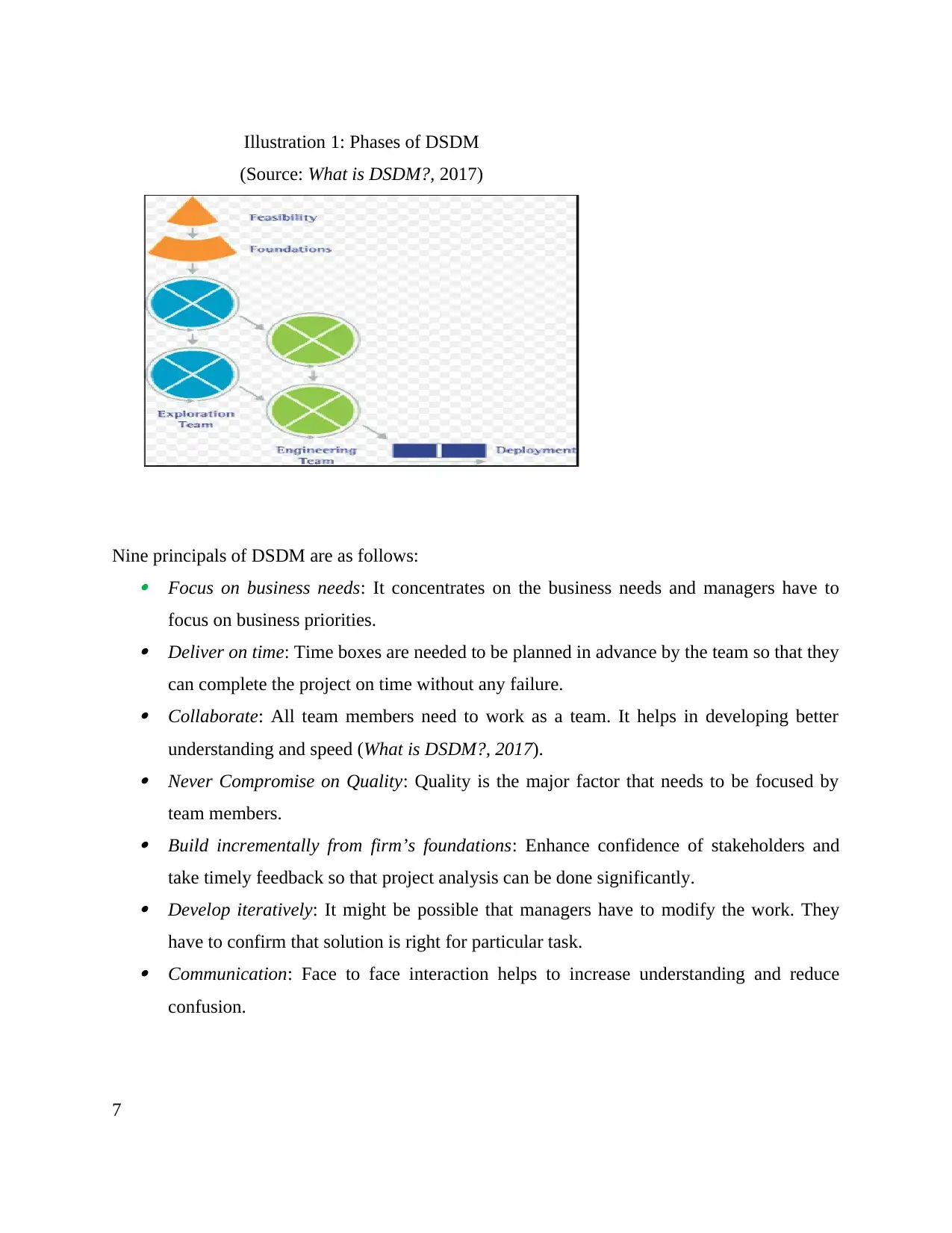
Illustration 1: Phases of DSDM
(Source: What is DSDM?, 2017)
Nine principals of DSDM are as follows: Focus on business needs: It concentrates on the business needs and managers have to
focus on business priorities. Deliver on time: Time boxes are needed to be planned in advance by the team so that they
can complete the project on time without any failure. Collaborate: All team members need to work as a team. It helps in developing better
understanding and speed (What is DSDM?, 2017). Never Compromise on Quality: Quality is the major factor that needs to be focused by
team members. Build incrementally from firm’s foundations: Enhance confidence of stakeholders and
take timely feedback so that project analysis can be done significantly. Develop iteratively: It might be possible that managers have to modify the work. They
have to confirm that solution is right for particular task. Communication: Face to face interaction helps to increase understanding and reduce
confusion.
7
(Source: What is DSDM?, 2017)
Nine principals of DSDM are as follows: Focus on business needs: It concentrates on the business needs and managers have to
focus on business priorities. Deliver on time: Time boxes are needed to be planned in advance by the team so that they
can complete the project on time without any failure. Collaborate: All team members need to work as a team. It helps in developing better
understanding and speed (What is DSDM?, 2017). Never Compromise on Quality: Quality is the major factor that needs to be focused by
team members. Build incrementally from firm’s foundations: Enhance confidence of stakeholders and
take timely feedback so that project analysis can be done significantly. Develop iteratively: It might be possible that managers have to modify the work. They
have to confirm that solution is right for particular task. Communication: Face to face interaction helps to increase understanding and reduce
confusion.
7
Paraphrase This Document
Need a fresh take? Get an instant paraphrase of this document with our AI Paraphraser
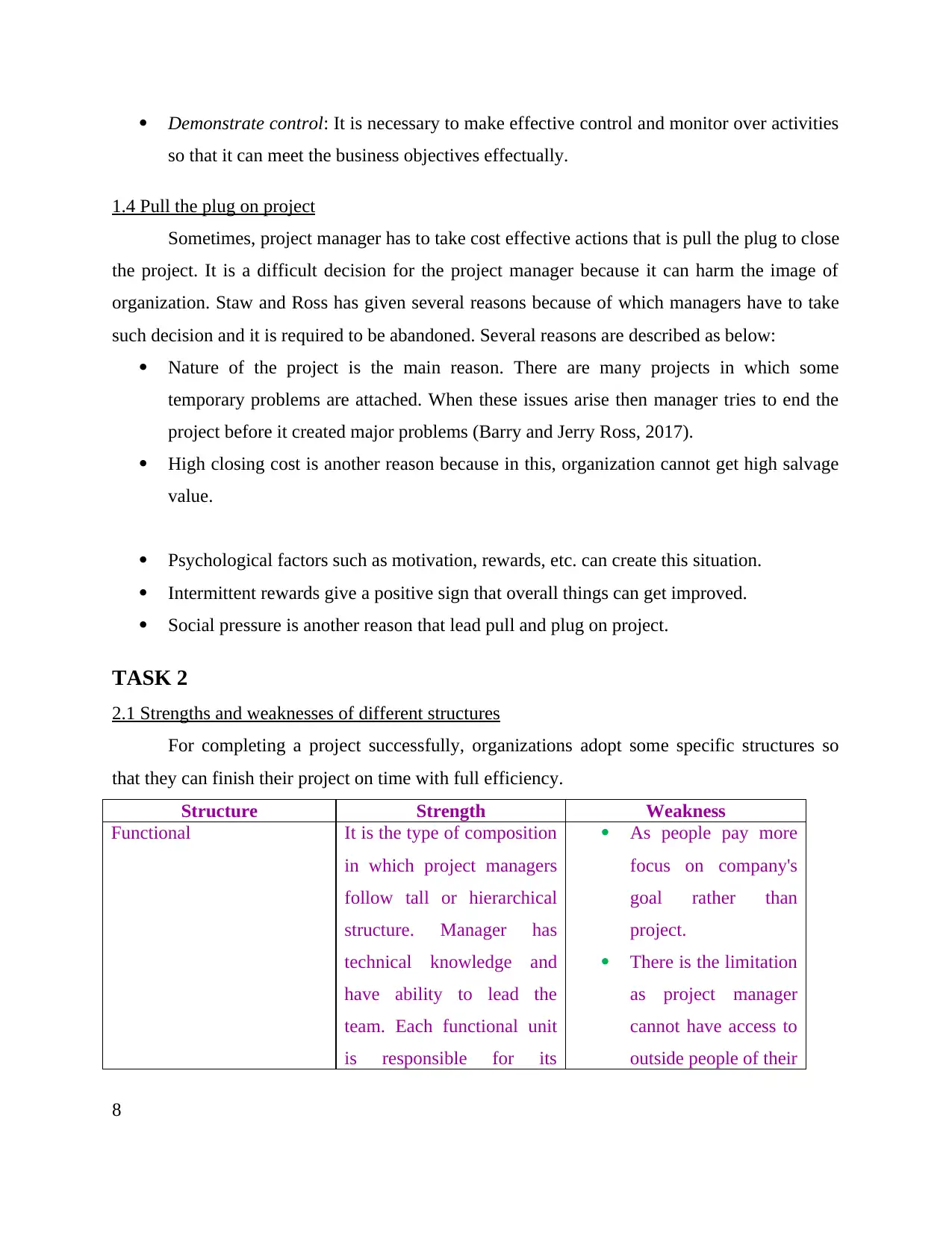
Demonstrate control: It is necessary to make effective control and monitor over activities
so that it can meet the business objectives effectually.
1.4 Pull the plug on project
Sometimes, project manager has to take cost effective actions that is pull the plug to close
the project. It is a difficult decision for the project manager because it can harm the image of
organization. Staw and Ross has given several reasons because of which managers have to take
such decision and it is required to be abandoned. Several reasons are described as below:
Nature of the project is the main reason. There are many projects in which some
temporary problems are attached. When these issues arise then manager tries to end the
project before it created major problems (Barry and Jerry Ross, 2017).
High closing cost is another reason because in this, organization cannot get high salvage
value.
Psychological factors such as motivation, rewards, etc. can create this situation.
Intermittent rewards give a positive sign that overall things can get improved.
Social pressure is another reason that lead pull and plug on project.
TASK 2
2.1 Strengths and weaknesses of different structures
For completing a project successfully, organizations adopt some specific structures so
that they can finish their project on time with full efficiency.
Structure Strength Weakness
Functional It is the type of composition
in which project managers
follow tall or hierarchical
structure. Manager has
technical knowledge and
have ability to lead the
team. Each functional unit
is responsible for its
As people pay more
focus on company's
goal rather than
project.
There is the limitation
as project manager
cannot have access to
outside people of their
8
so that it can meet the business objectives effectually.
1.4 Pull the plug on project
Sometimes, project manager has to take cost effective actions that is pull the plug to close
the project. It is a difficult decision for the project manager because it can harm the image of
organization. Staw and Ross has given several reasons because of which managers have to take
such decision and it is required to be abandoned. Several reasons are described as below:
Nature of the project is the main reason. There are many projects in which some
temporary problems are attached. When these issues arise then manager tries to end the
project before it created major problems (Barry and Jerry Ross, 2017).
High closing cost is another reason because in this, organization cannot get high salvage
value.
Psychological factors such as motivation, rewards, etc. can create this situation.
Intermittent rewards give a positive sign that overall things can get improved.
Social pressure is another reason that lead pull and plug on project.
TASK 2
2.1 Strengths and weaknesses of different structures
For completing a project successfully, organizations adopt some specific structures so
that they can finish their project on time with full efficiency.
Structure Strength Weakness
Functional It is the type of composition
in which project managers
follow tall or hierarchical
structure. Manager has
technical knowledge and
have ability to lead the
team. Each functional unit
is responsible for its
As people pay more
focus on company's
goal rather than
project.
There is the limitation
as project manager
cannot have access to
outside people of their
8
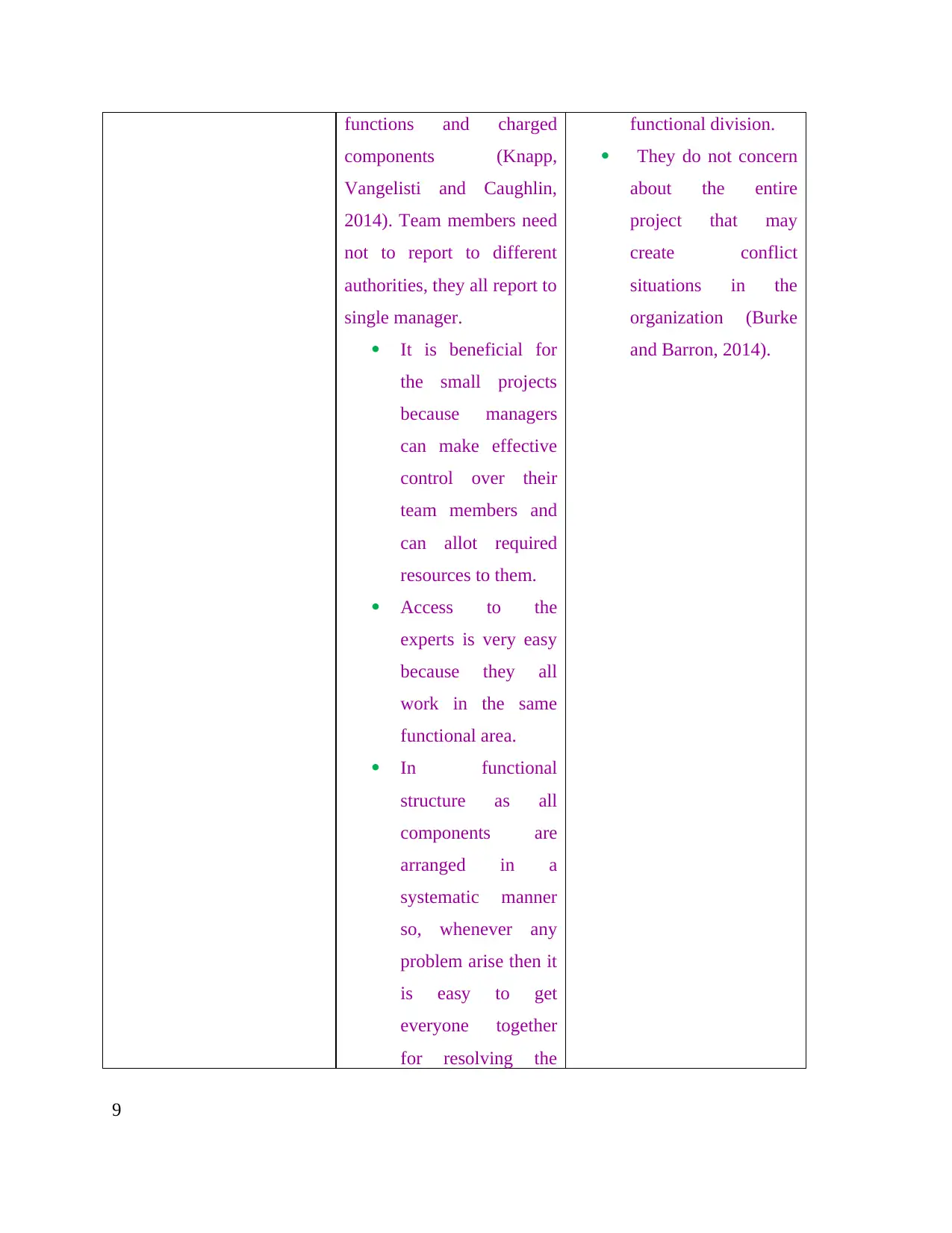
functions and charged
components (Knapp,
Vangelisti and Caughlin,
2014). Team members need
not to report to different
authorities, they all report to
single manager.
It is beneficial for
the small projects
because managers
can make effective
control over their
team members and
can allot required
resources to them.
Access to the
experts is very easy
because they all
work in the same
functional area.
In functional
structure as all
components are
arranged in a
systematic manner
so, whenever any
problem arise then it
is easy to get
everyone together
for resolving the
functional division.
They do not concern
about the entire
project that may
create conflict
situations in the
organization (Burke
and Barron, 2014).
9
components (Knapp,
Vangelisti and Caughlin,
2014). Team members need
not to report to different
authorities, they all report to
single manager.
It is beneficial for
the small projects
because managers
can make effective
control over their
team members and
can allot required
resources to them.
Access to the
experts is very easy
because they all
work in the same
functional area.
In functional
structure as all
components are
arranged in a
systematic manner
so, whenever any
problem arise then it
is easy to get
everyone together
for resolving the
functional division.
They do not concern
about the entire
project that may
create conflict
situations in the
organization (Burke
and Barron, 2014).
9
⊘ This is a preview!⊘
Do you want full access?
Subscribe today to unlock all pages.

Trusted by 1+ million students worldwide
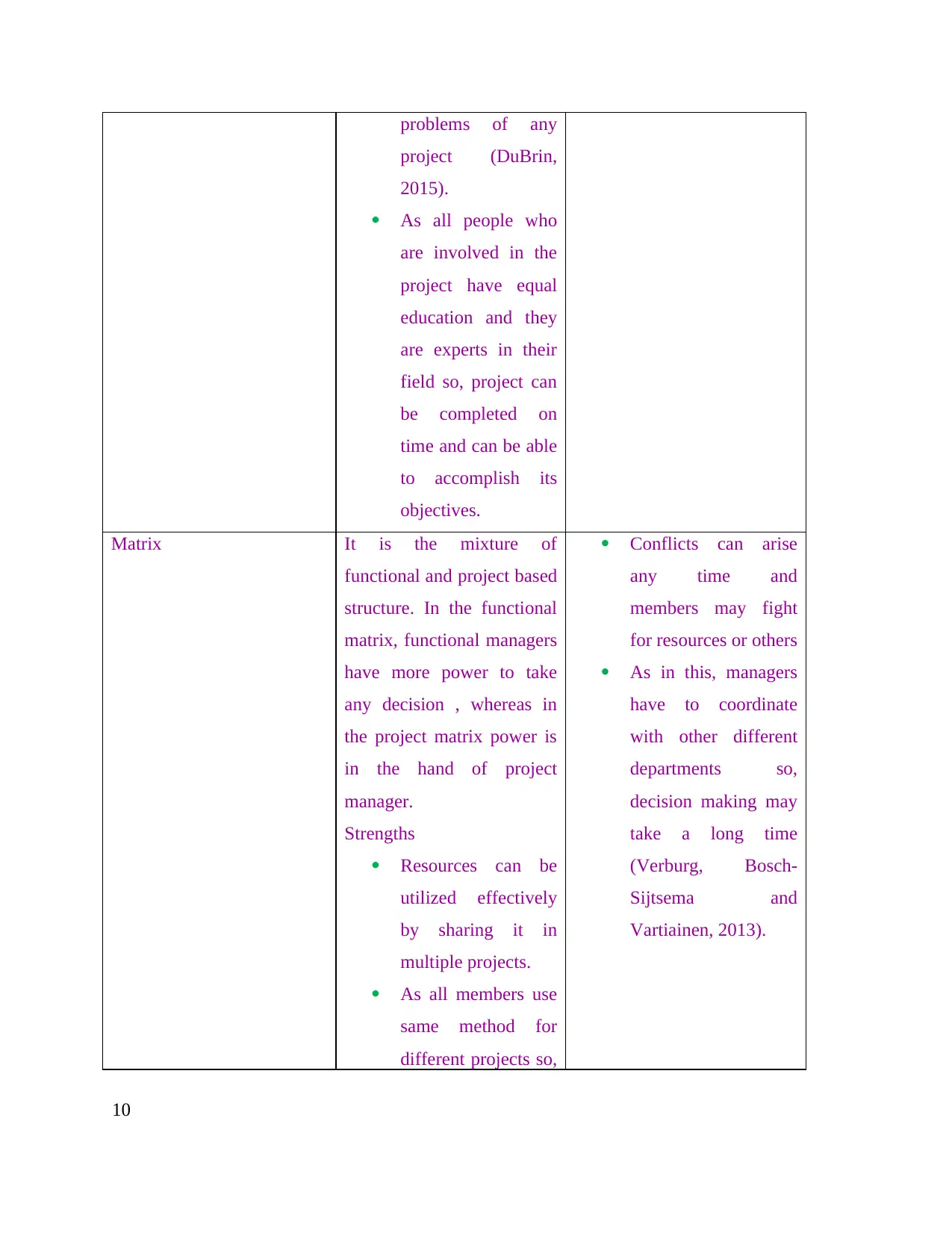
problems of any
project (DuBrin,
2015).
As all people who
are involved in the
project have equal
education and they
are experts in their
field so, project can
be completed on
time and can be able
to accomplish its
objectives.
Matrix It is the mixture of
functional and project based
structure. In the functional
matrix, functional managers
have more power to take
any decision , whereas in
the project matrix power is
in the hand of project
manager.
Strengths
Resources can be
utilized effectively
by sharing it in
multiple projects.
As all members use
same method for
different projects so,
Conflicts can arise
any time and
members may fight
for resources or others
As in this, managers
have to coordinate
with other different
departments so,
decision making may
take a long time
(Verburg, Bosch-
Sijtsema and
Vartiainen, 2013).
10
project (DuBrin,
2015).
As all people who
are involved in the
project have equal
education and they
are experts in their
field so, project can
be completed on
time and can be able
to accomplish its
objectives.
Matrix It is the mixture of
functional and project based
structure. In the functional
matrix, functional managers
have more power to take
any decision , whereas in
the project matrix power is
in the hand of project
manager.
Strengths
Resources can be
utilized effectively
by sharing it in
multiple projects.
As all members use
same method for
different projects so,
Conflicts can arise
any time and
members may fight
for resources or others
As in this, managers
have to coordinate
with other different
departments so,
decision making may
take a long time
(Verburg, Bosch-
Sijtsema and
Vartiainen, 2013).
10
Paraphrase This Document
Need a fresh take? Get an instant paraphrase of this document with our AI Paraphraser
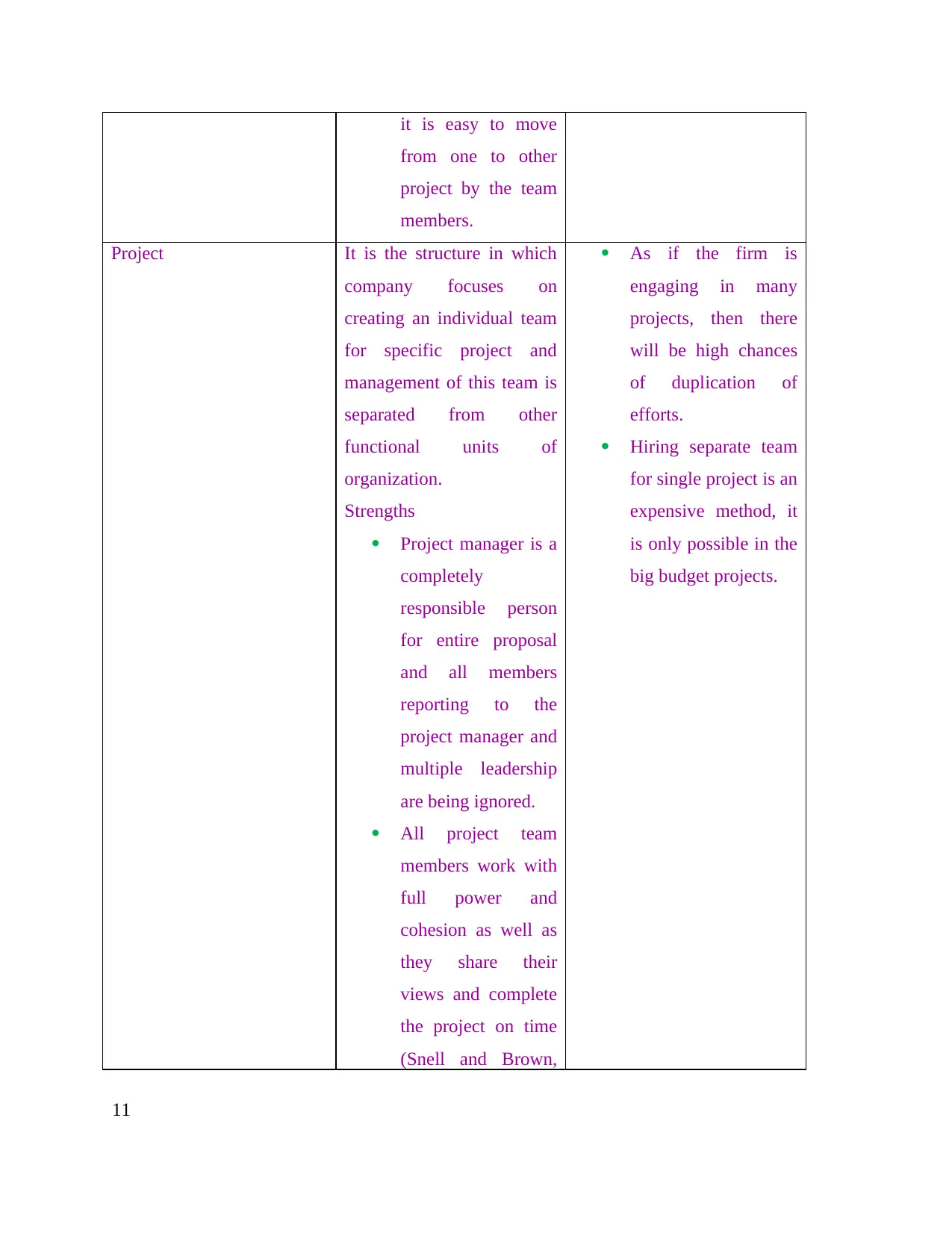
it is easy to move
from one to other
project by the team
members.
Project It is the structure in which
company focuses on
creating an individual team
for specific project and
management of this team is
separated from other
functional units of
organization.
Strengths
Project manager is a
completely
responsible person
for entire proposal
and all members
reporting to the
project manager and
multiple leadership
are being ignored.
All project team
members work with
full power and
cohesion as well as
they share their
views and complete
the project on time
(Snell and Brown,
As if the firm is
engaging in many
projects, then there
will be high chances
of duplication of
efforts.
Hiring separate team
for single project is an
expensive method, it
is only possible in the
big budget projects.
11
from one to other
project by the team
members.
Project It is the structure in which
company focuses on
creating an individual team
for specific project and
management of this team is
separated from other
functional units of
organization.
Strengths
Project manager is a
completely
responsible person
for entire proposal
and all members
reporting to the
project manager and
multiple leadership
are being ignored.
All project team
members work with
full power and
cohesion as well as
they share their
views and complete
the project on time
(Snell and Brown,
As if the firm is
engaging in many
projects, then there
will be high chances
of duplication of
efforts.
Hiring separate team
for single project is an
expensive method, it
is only possible in the
big budget projects.
11
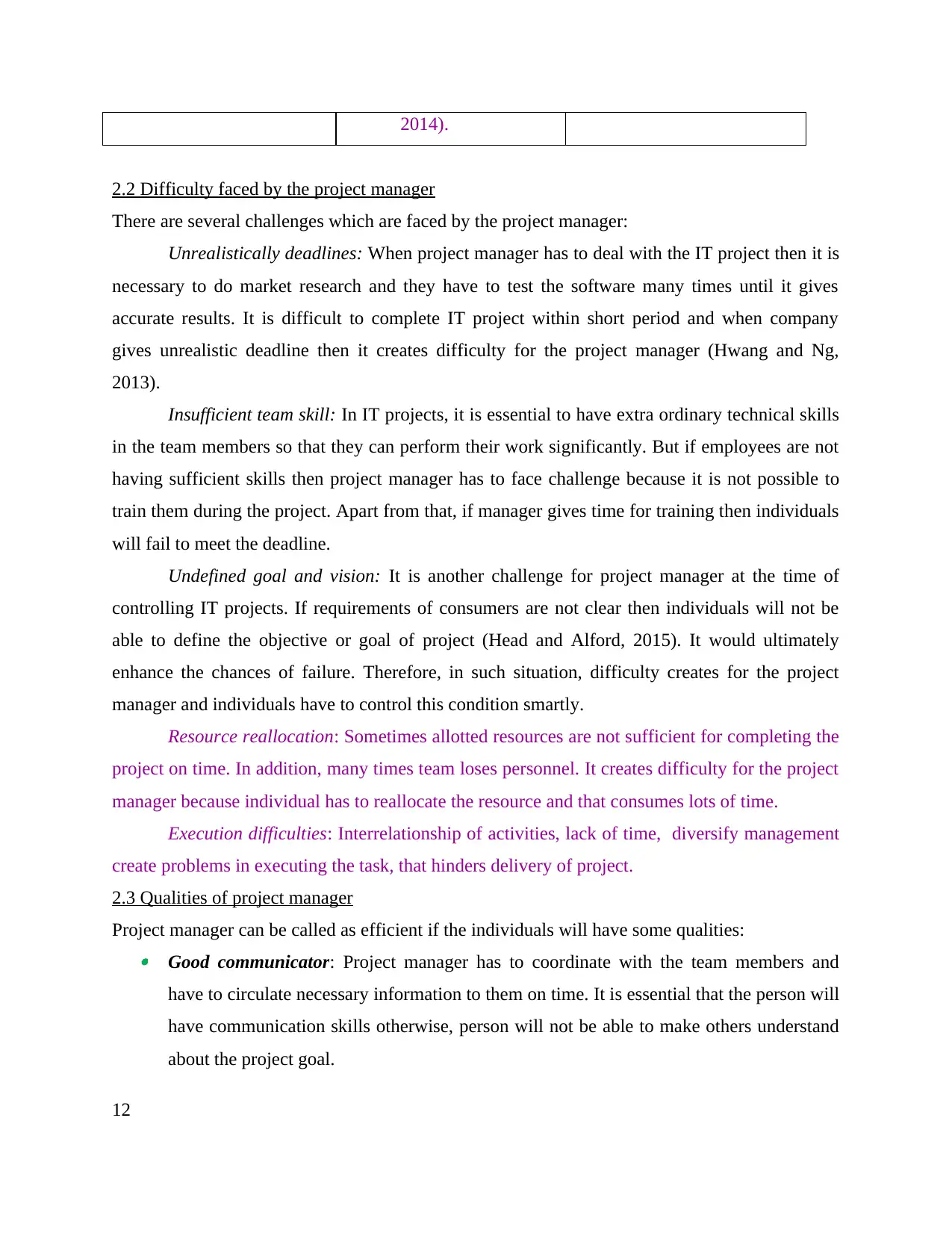
2014).
2.2 Difficulty faced by the project manager
There are several challenges which are faced by the project manager:
Unrealistically deadlines: When project manager has to deal with the IT project then it is
necessary to do market research and they have to test the software many times until it gives
accurate results. It is difficult to complete IT project within short period and when company
gives unrealistic deadline then it creates difficulty for the project manager (Hwang and Ng,
2013).
Insufficient team skill: In IT projects, it is essential to have extra ordinary technical skills
in the team members so that they can perform their work significantly. But if employees are not
having sufficient skills then project manager has to face challenge because it is not possible to
train them during the project. Apart from that, if manager gives time for training then individuals
will fail to meet the deadline.
Undefined goal and vision: It is another challenge for project manager at the time of
controlling IT projects. If requirements of consumers are not clear then individuals will not be
able to define the objective or goal of project (Head and Alford, 2015). It would ultimately
enhance the chances of failure. Therefore, in such situation, difficulty creates for the project
manager and individuals have to control this condition smartly.
Resource reallocation: Sometimes allotted resources are not sufficient for completing the
project on time. In addition, many times team loses personnel. It creates difficulty for the project
manager because individual has to reallocate the resource and that consumes lots of time.
Execution difficulties: Interrelationship of activities, lack of time, diversify management
create problems in executing the task, that hinders delivery of project.
2.3 Qualities of project manager
Project manager can be called as efficient if the individuals will have some qualities: Good communicator: Project manager has to coordinate with the team members and
have to circulate necessary information to them on time. It is essential that the person will
have communication skills otherwise, person will not be able to make others understand
about the project goal.
12
2.2 Difficulty faced by the project manager
There are several challenges which are faced by the project manager:
Unrealistically deadlines: When project manager has to deal with the IT project then it is
necessary to do market research and they have to test the software many times until it gives
accurate results. It is difficult to complete IT project within short period and when company
gives unrealistic deadline then it creates difficulty for the project manager (Hwang and Ng,
2013).
Insufficient team skill: In IT projects, it is essential to have extra ordinary technical skills
in the team members so that they can perform their work significantly. But if employees are not
having sufficient skills then project manager has to face challenge because it is not possible to
train them during the project. Apart from that, if manager gives time for training then individuals
will fail to meet the deadline.
Undefined goal and vision: It is another challenge for project manager at the time of
controlling IT projects. If requirements of consumers are not clear then individuals will not be
able to define the objective or goal of project (Head and Alford, 2015). It would ultimately
enhance the chances of failure. Therefore, in such situation, difficulty creates for the project
manager and individuals have to control this condition smartly.
Resource reallocation: Sometimes allotted resources are not sufficient for completing the
project on time. In addition, many times team loses personnel. It creates difficulty for the project
manager because individual has to reallocate the resource and that consumes lots of time.
Execution difficulties: Interrelationship of activities, lack of time, diversify management
create problems in executing the task, that hinders delivery of project.
2.3 Qualities of project manager
Project manager can be called as efficient if the individuals will have some qualities: Good communicator: Project manager has to coordinate with the team members and
have to circulate necessary information to them on time. It is essential that the person will
have communication skills otherwise, person will not be able to make others understand
about the project goal.
12
⊘ This is a preview!⊘
Do you want full access?
Subscribe today to unlock all pages.

Trusted by 1+ million students worldwide
1 out of 21
Related Documents
Your All-in-One AI-Powered Toolkit for Academic Success.
+13062052269
info@desklib.com
Available 24*7 on WhatsApp / Email
![[object Object]](/_next/static/media/star-bottom.7253800d.svg)
Unlock your academic potential
Copyright © 2020–2025 A2Z Services. All Rights Reserved. Developed and managed by ZUCOL.





